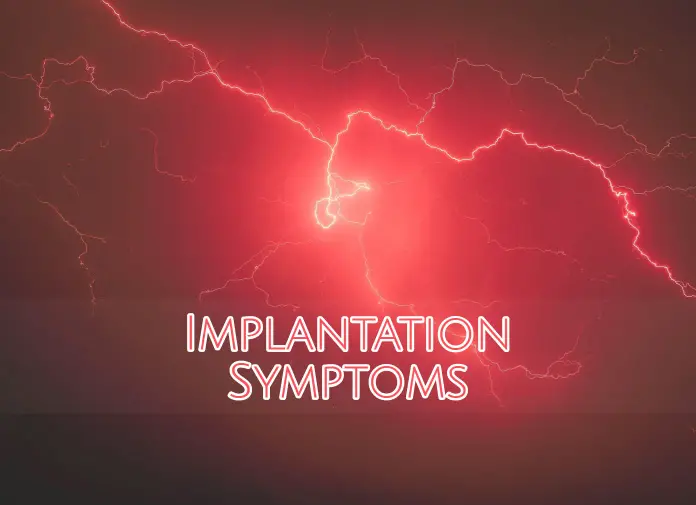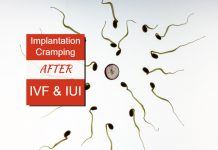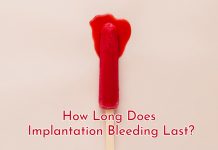Most women know only two symptoms of implantation. They are implantation bleeding and cramping. But they don’t know that there are 10 implantation symptoms that indicate possible motherhood.
Implantation mostly goes without the knowledge of women. But it is so confirmatory and is a sure sign of pregnancy. If your implantation is successful, then the chances of healthy full-term pregnancy go up by a huge leap. Implantation cramping and nine other implantation symptoms will help you identify when you are undergoing it.

What is fertilization?
When the sperm enters the vagina, they have to travel a long distance before being able to fertilize the egg. After this, sperms undergo capacitation for being able to withstand the harsh conditions of the vagina.
Later on, only a small fraction of sperms remain from the 300 million that first came. Fertilization is the fusion of a healthy sperm head into an ovum. It leads to the mixing of genes of mother and father. The egg is now a zygote. During fertilization, the egg membrane allows only one sperm in.
The sperm has a head, tail, and neck. The head of sperm has many enzymes that dissolve the meshwork around the egg. The head penetrates in and creates a cone of fertilization. Through this, the genetic material along with the cell dividing apparatus moves in the egg.
The female egg cannot divide to lead to virgin birth because it lacks the machinery for the division. Also, the cell has only half the number of chromosomes or genetic matter. After fertilization, the genetic composition returns to normal.
Now the egg is capable of dividing and so starts splitting to form a young embryo. After creating a ball of 64 units, it attaches to the lining of the uterus (a process known as implantation) for obtaining nutrients and energy for further growth.
Is cramping during implantation normal?
When this 64 celled structure invades the uterine lining, it leads to compression of blood capillaries. The blood coming out from them stays inside. Later it comes out as implantation bleeding.
When the embryo approaches the lining, it attacks it using its fibers. The trophoblast is a layer that has fibers for being able to puncture the wall of the uterus.
The endometrial glands also secrete many substances that facilitate the movement of the egg.
When this happens mild tingling sensations in the vagina are normal. You might feel a downward pull and slight cramping. Implantation cramps are mild and short-term. They are normal until they don’t cause pain.
Cramping occurs in some women, and implantation bleeding also occurs in the case of 1/3rd pregnancies. But implantation has to happen in the case of every pregnancy.
Even if you don’t see any symptoms of implantation still if you are pregnant, then implantation did occur. There no way to bypass the stage of implantation and become pregnant.
IVF and implantation cramping
After IVF implantation cramping is not an immediate effect. If you just had an IVF, you may have the after-effects of the surgical process.
During implantation, the embryo has to be of about 64 cells.
In vitro fertilization is the technique where the mixture of a woman’s egg and sperms is left in a test tube.
At the right temperature, fertilization occurs outside the body. In vitro means outside a living system and in a chemically synthesized environment. In vivo is what occurs inside the living system.
After the fertilization when the embryo stage arrives, it is directly placed inside the uterus. In this case, you’ll have implantation cramping soon after egg embedment. Any irritation after egg retrieval is because of the procedures and not because of implantation. Fertility drugs prescription during IVF can also cause cramping.
How to distinguish implantation symptoms?
Implantation symptoms differ from period and disease. They have a few signs that make them stand apart. You can look for these ten implantation symptoms to distinguish.
1) Implantation bleeding
Due to egg embedment, the walls of the uterus bleed and lead to implantation bleeding. It is the sign of implantation that you can see externally.
Implantation bleeding is a few milliliters and lasts for only two days. The color of the implantation spotting is brown or pink. It is because the blood is old by the time it travels down the uterus.
2) Implantation cramps
When you have cramps before the expected PMS, you know that there is something different. Implantation cramping occurs about a week earlier than PMS or menstrual cramps. They are mild and go away soon. During the period the cramps are unbearable and last longer. PMS cramps and implantation cramps differ by their timing.
3) Implantation dip
Implantation dip is the fall of BBT in case of pregnancy after ovulation. You cannot be sure about implantation from a drop in BBT. But if there is a triphasic pattern of basal body temperature, then you can detect pregnancy. In other cases, the BBT does not fall after ovulation.
4) Changes in cervical mucus
After implantation, the cervical mucus increases in amount. It is for forming a mucus plug to support the growth of the embryo. In the case of a period, you have dry days because fertilization did not occur. Changes in cervical mucus can tell a lot about your vaginal health.
5) Nausea
Nausea is one of the implantation symptoms that does not happen in the case of a period. Spotting and nausea before the period are because of implantation. Later you’ll have morning sickness once you reach the stage of early pregnancy.
6) Bloating
Bloating during pregnancy is due to gas and constipation. It is the reason for insomnia and other problems later. Implantation leads to bloating during early pregnancy. The hormones and accommodation make the digestive system less efficient.
7) Fatigue
Early stages of pregnancy like implantation require a lot of energy. It is natural to feel tired and have fatigue. You can relax and once implantation is complete your energy levels will pick up.
8) Tenderness of breasts
The rising hCG after implantation causes an increase in pregnancy hormones. Your breasts have to prepare for breastfeeding whether you decide to do it or not. The nipples will become dark, and the breasts will be sore. You might hurt even on the slightest touch.
9) Heightened Senses
During implantation the nasal membrane becomes sensitive. Even your skin receptors are sensitive to all touches. You might even feel the inner organs and the implantation. But most women don’t feel implantation.
10) Changes in the cervix
The cervix will feel softer, and it will rise. An increased amount of mucus will make it feel wet all the while. You might have some itching due to the moisture.
Implantation bleeding: Conception or Abnormal vaginal bleeding?
Implantation bleeding is a sign of conception. Abnormal vaginal bleeding is when the amount of bleeding is too much.
Bright red blood is also abnormal and not a sign of implantation. If you continue to have cramps and other pain symptoms, then you have not conceived.
A tubal pregnancy is not a healthy pregnancy and cannot continue till the end. When you see all symptoms of implantation bleeding you can take a pregnancy test after 4-5 days. It will be from the day the symptoms started.
If you get a positive pregnancy test, then you had an implantation. The implantation signs negative pregnancy test is a sign that you had abnormal bleeding. You need to tell your doctor if the cramps intensify.
How to relieve implantation cramping?
Implantation cramping is not intense, and you may not feel the need to take painkillers. Over the counter pain, relievers or muscle relaxants can cause the relaxation of the uterus. Itis not suitable for implantation. You can try home remedies for relieving implantation cramping.
Natural ways to treat implantation cramps
- Use a hot and cold compress: Don’t use it continuously because the temperature fluctuation is not good. Also, avoid using an extremely cold or hot compress. Go for mediocre strength heat or cold.
- Eat dark chocolate: Get caffeine-free chocolate and have it. Dark chocolate has antioxidants and alkaloids that help reduce the pain signals to the brain. And you deserve the chocolate cocoa.
- Lie down and relax: During implantation, it is essential that you take care of yourself. Not only physically but also mentally you need to be at rest. If you are under stress or anxiety, it can worsen the cramps.
- Avoid eating food that causes bloating: Bloating aggravates implantation cramps. Avoid fried stuff and food that is difficult to digest. Eat a portion of fruits when you’re hungry.
- Go for a walk and take a bottle of lukewarm water: Walking and drinking lukewarm water relieve any cramping. The movements reduce the twisting of the muscles and walls of organs. You must not jog or run during implantation cramping. It is so mild that you might not realize and go for a heavy workout. It is not safe for your baby and can cause implantation defects.
Intensifying cramps: How to act?
Report to your doctor without a second thought when the cramps get worse. Intensifying cramps is a sign that you don’t have normal implantation.
Ectopic pregnancy or Molar pregnancy leads to excruciatingly painful cramps. You need to relax and calm down.
If you have cysts in your ovaries, they can twist and cause unbearable pain. Do not take any painkiller or muscle relaxant in such cases. They will only lead to serious health complications.
Risks of implantation cramping
There is no risk associated with implantation cramping. Implantation cramps are mild and not painful. They go with time and don’t cause any distress. You will not even realize that there was any cramping.
Even without implantation cramping, you can be pregnant because only 1/3rd of women experience the symptoms. If the cramps intensify, then there is a risk of threatened miscarriage.
Implantation failure causes the removal of egg and endometrial lining along with very early miscarriage.




![Implantation Bleeding With Twins [How long does IB last with twins?] Implantation Bleeding With Twins](https://www.pregnanteve.com/wp-content/uploads/2019/01/implantation-bleeding-with-twins-218x150.jpg)




